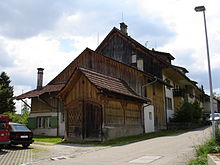Bertschikon near Gossau
| Bertschikon | ||
|---|---|---|
| State : |
|
|
| Canton : |
|
|
| District : | Hinwil | |
| Political community : | Gossau | |
| Postal code : | 8614 | |
| Coordinates : | 699 698 / 241896 | |
| Height : | 503 m above sea level M. | |
| map | ||
|
|
||
Bertschikon is an outside guard for the community of Gossau ZH ( Hinwil district ) in the canton of Zurich in Switzerland.
geography
Bertschikon is located in the middle of the drumlin landscape of the Zurich Oberland and borders the cities of Uster and Wetzikon .
history
Early history
The Bertschikon settlement appeared late in written documents. It was first mentioned in 1279. Nevertheless, the earliest traces of Gossau's settlement were discovered in this watch: a bowl stone from the early Bronze Age that was found on the Fluh Hexrüti, but is lost today. A second find of a bowl stone decorates Bertschik village square today.
middle Ages
Bertschikon, like the neighboring hamlets of Binzikon, Itzikon, Wernetshausen and the villages of Gossau, Grüt , Ottikon - belonged to the medieval Dingstatt Binzikon. A thingstead is a relic from the Alemannic period, derived from the word " Thing ", which denoted a tribal assembly for the administration of justice. The Dingstatt Binzikon filled one of the gaps in the city-state of Zurich that emerged when the city-state expanded its territory between the 13th and 15th centuries, mainly through the purchase of real estate. Not all local landlords gave up their rights to Zurich.
Most of the residents of Dingstatt Binzikon benefited from special freedoms: Although they paid tithes to a noble or ecclesiastical landowner, they were not - as is customary in feudalism - his serfs . As free farmers, they had comparatively generous rights. Among other things, they could hold court on questions of civil law. The corresponding court days took place twice a year either in Binzikon or Bertschikon. The coat of arms of the guard with the three red roses is a reminder of the former rule in Bertschikon. It is the roses of the city of Rapperswil , which in 1415 acquired a first part of the rights to Bertschikon from a country nobleman and in 1494 also bought the rights to the St. Nicholas chapel from the villagers. As the owner of the guard, the rose city drew in the tithing until 1830.
Modern times
Despite their privileged position, Bertschikon's free peasants were poor. This was not least due to the topography of the village, which is characterized by hills (drumlins). The land forced the small farmers to cultivate their land according to the Egarten system instead of being able to convert to the more lucrative three-part farming . With the home industry that emerged in the late 18th century, they were able to earn extra income. It gave the village a certain boom, but it was thwarted by the crisis in the cotton industry in the second half of the 18th century. As early as 1816, a small textile factory was established in Bertschikon, the first in the Gossau community to which Wacht belongs. Nevertheless, no real industry could develop here. In the second half of the 18th century, as everywhere in Gossau, the farms switched to dairy farming as the main branch. This brought a certain degree of prosperity to the village. Bertschikon remained a pure farming village until the middle of the 20th century. In the course of the boom in the post-war period, however, the Wacht developed into a sought-after place to live and its population increased considerably: Between 1950 and 2012, the population tripled.
Attractions
traffic
The VZO buses run every quarter of an hour to Uster and Gossau on weekdays . Every half hour on public holidays, weekends and evenings from 8:00 p.m.
politics
Politically, Bertschikon belongs to the municipality of Gossau ZH (Hinwil district). With the postal code 8614, however, no clear assignment is made, because the neighboring watch Sulzbach ZH has exactly the same, but belongs to the district and municipality of Uster .
Economy / trade
The village has a Volg , a hairdresser and two taverns (“Zur alten Post” and “Traube”), a construction company and a carpenter's shop are also located in Bertschikon. Four farms also sell their seasonal products at their self-service stands, and bread or wood-fired bread is offered once a week. Outside Bertschikon in the direction of Wetzikon is the Zurich Oberland Sheep Wool Center with a small farm shop for sheep products.
school
There is a kindergarten in the village as well as the Mannnetsriet primary school. The new construction of the kindergarten made it possible to combine the 1st class with the kindergarten to form the elementary level (see sub-chapter) . After primary school, the pupils attend either the grammar school ( canton school Zürcher Oberland ) in Wetzikon or the secondary school in Gossau ZH.
population
In the latest population survey from 2012, around 1050 people live in Beritschikon. In 1950 Bertschikon still had 345 inhabitants.
Web links
Individual evidence
- ^ Hansruedi Galliker and Thomas-Peter Binder: Gossau ZH. From abject poverty to a popular place to live. Gossau 2014.


